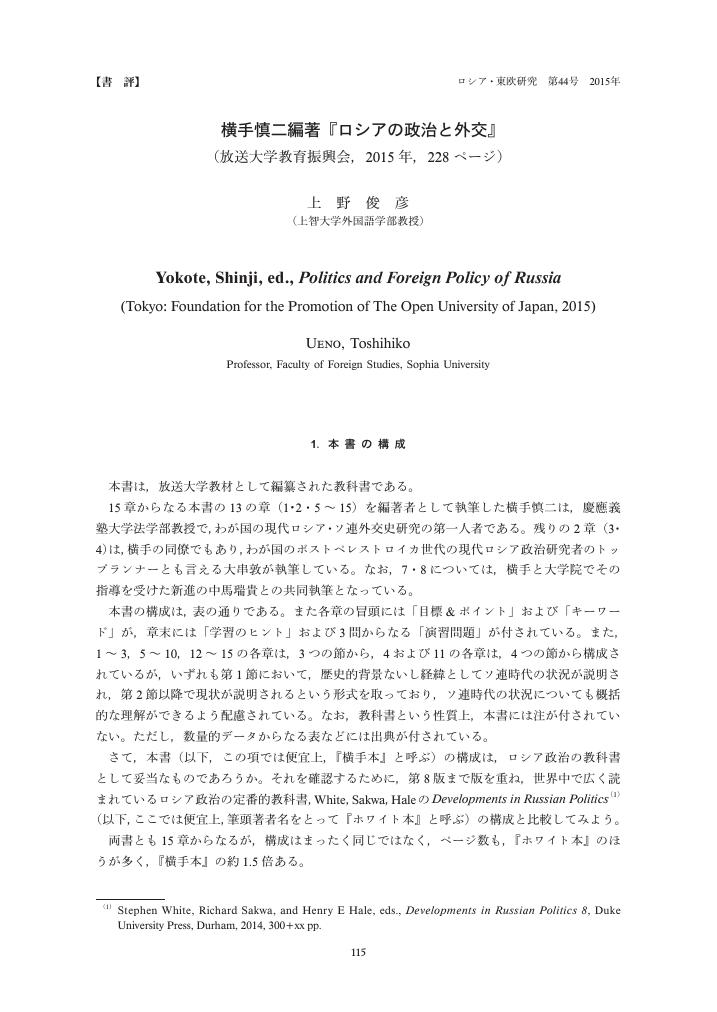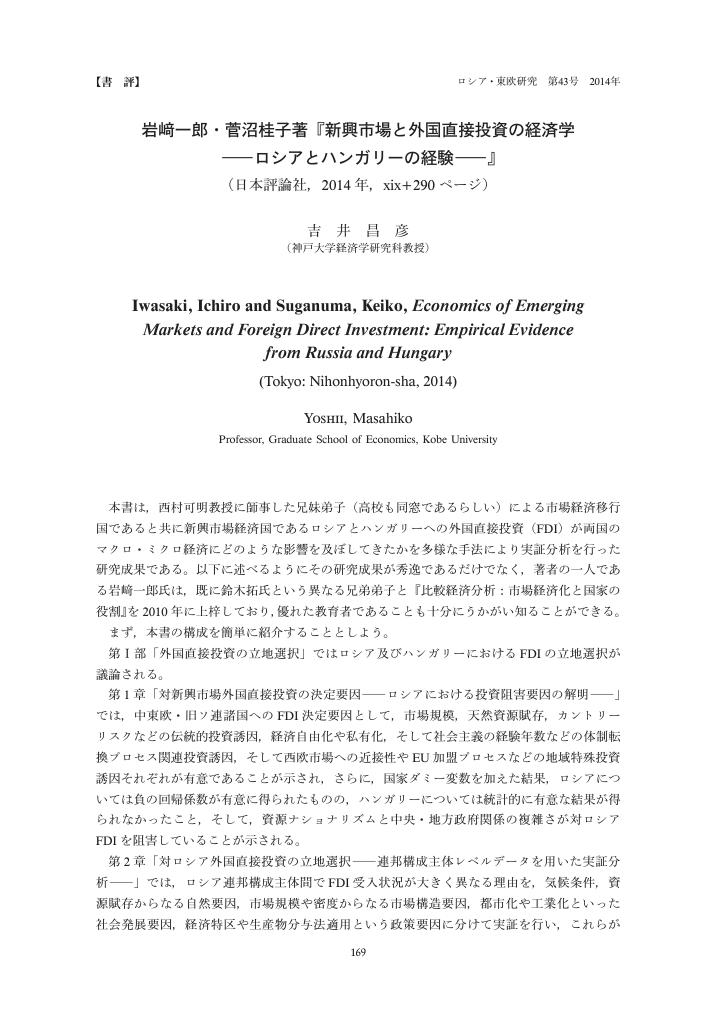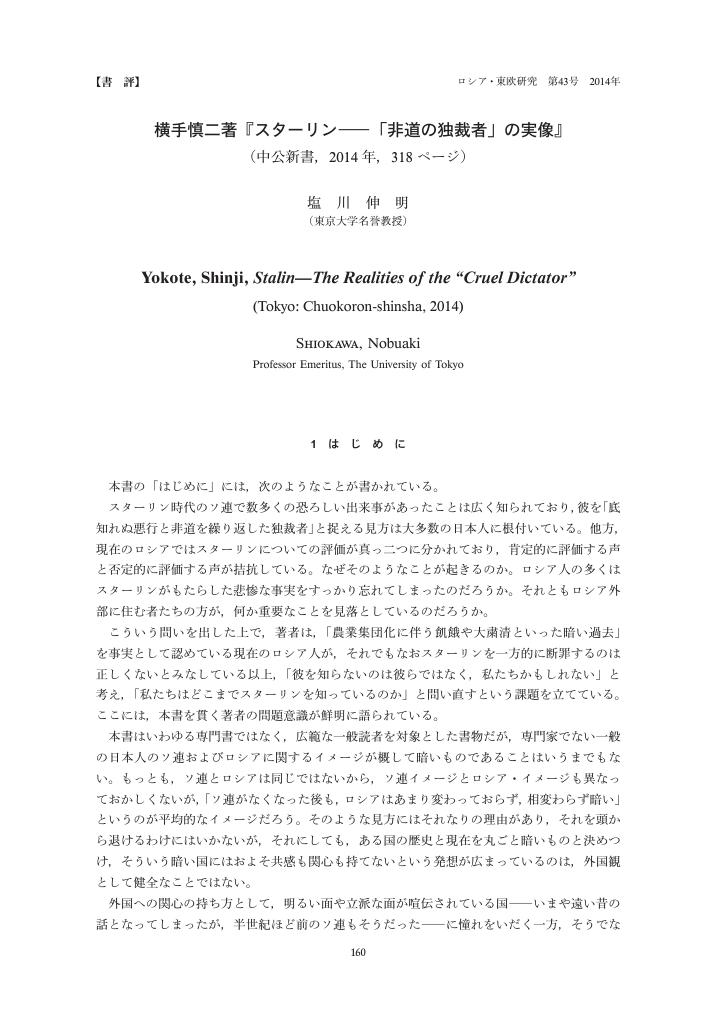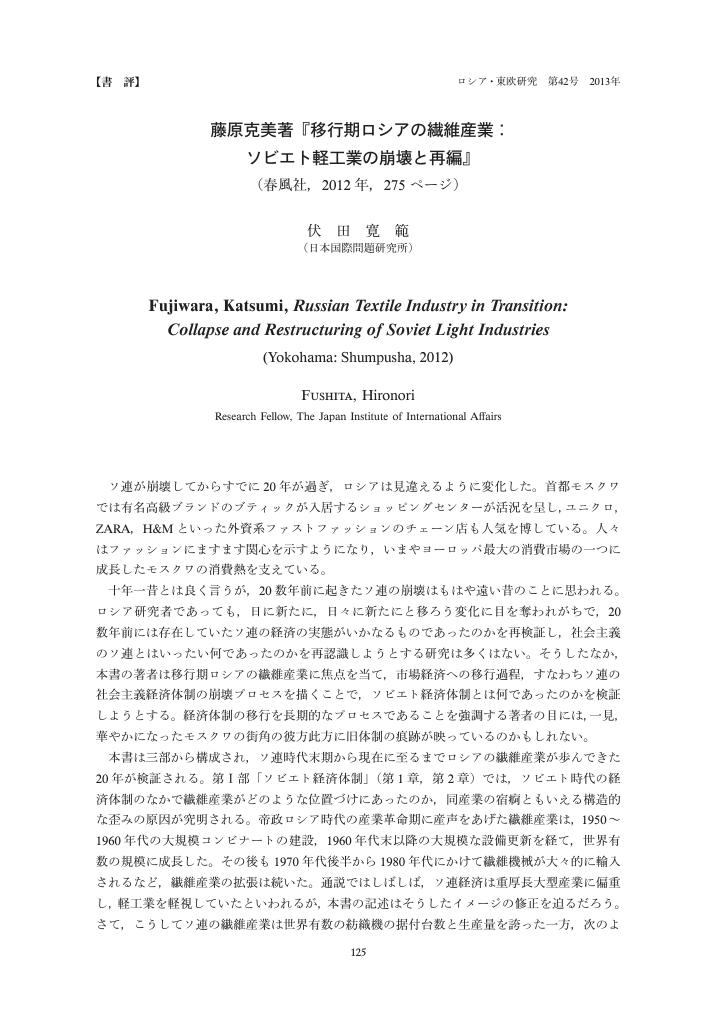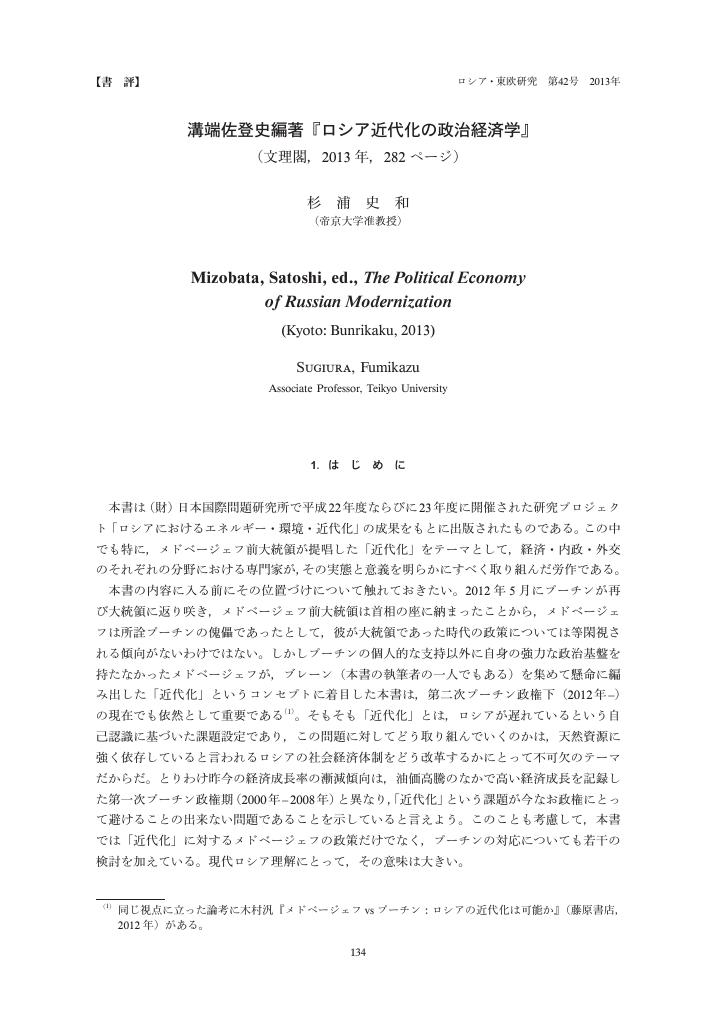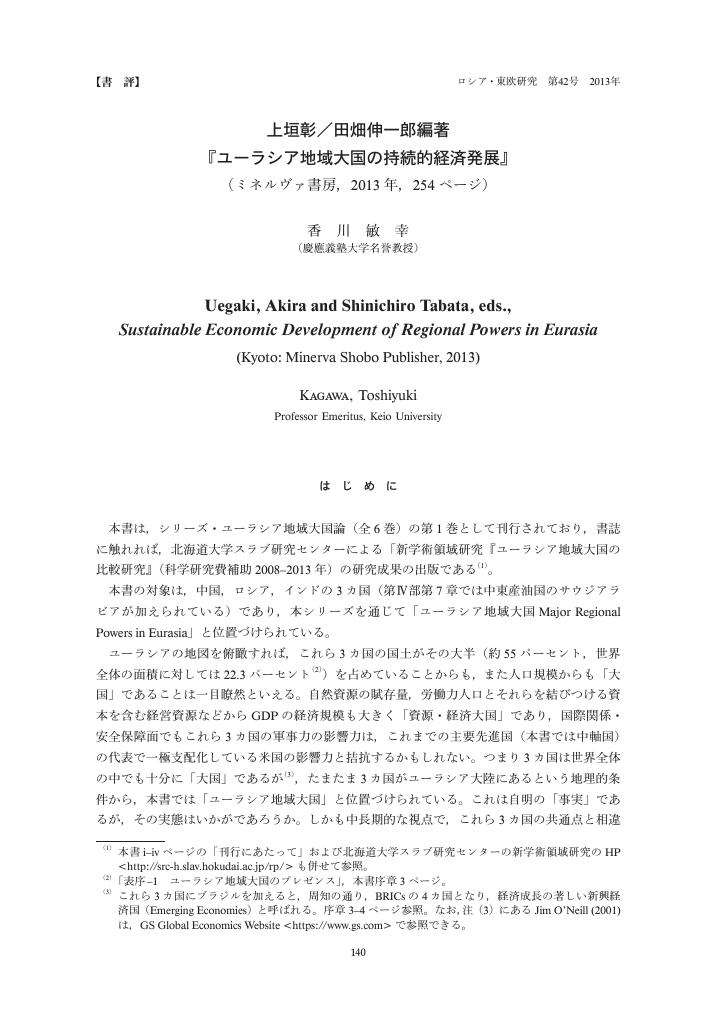1 0 0 0 OA 横手慎二編著『ロシアの政治と外交』 (放送大学教育振興会,2015年,228ページ)
- 著者
- 上野 俊彦
- 出版者
- ロシア・東欧学会
- 雑誌
- ロシア・東欧研究 (ISSN:13486497)
- 巻号頁・発行日
- vol.2015, no.44, pp.115-119, 2015 (Released:2017-08-18)
- 著者
- 吉井 昌彦
- 出版者
- ロシア・東欧学会
- 雑誌
- ロシア・東欧研究 (ISSN:13486497)
- 巻号頁・発行日
- vol.2014, no.43, pp.169-172, 2014 (Released:2016-09-09)
- 著者
- 湯浅 剛
- 出版者
- ロシア・東欧学会
- 雑誌
- ロシア・東欧研究 (ISSN:13486497)
- 巻号頁・発行日
- vol.2014, no.43, pp.173-175, 2014 (Released:2016-09-09)
- 参考文献数
- 1
1 0 0 0 OA デイヴィド・シンメルペンニンク=ファン=デル=オイエ著(浜由樹子訳)『ロシアのオリエンタリズム―ロシアのアジア・イメージ,ピョートル大帝から亡命者まで』 (成文社,2013年,350ページ)
- 著者
- 黒岩 幸子
- 出版者
- ロシア・東欧学会
- 雑誌
- ロシア・東欧研究 (ISSN:13486497)
- 巻号頁・発行日
- vol.2014, no.43, pp.176-179, 2014 (Released:2016-09-09)
- 著者
- 大津 定美
- 出版者
- ロシア・東欧学会
- 雑誌
- ロシア・東欧研究 (ISSN:13486497)
- 巻号頁・発行日
- vol.2014, no.43, pp.180-184, 2014 (Released:2016-09-09)
- 参考文献数
- 6
- 著者
- 山添 博史
- 出版者
- ロシア・東欧学会
- 雑誌
- ロシア・東欧研究 (ISSN:13486497)
- 巻号頁・発行日
- vol.2014, no.43, pp.185-187, 2014 (Released:2016-09-09)
1 0 0 0 OA 存在感のあるロシア・東欧学会をめざして
- 著者
- 溝端 佐登史
- 出版者
- ロシア・東欧学会
- 雑誌
- ロシア・東欧研究 (ISSN:13486497)
- 巻号頁・発行日
- vol.2015, no.44, pp.1-3, 2015 (Released:2017-08-18)
- 著者
- 羽場 久美子
- 出版者
- ロシア・東欧学会
- 雑誌
- ロシア・東欧研究 (ISSN:13486497)
- 巻号頁・発行日
- vol.2015, no.44, pp.4, 2015 (Released:2017-08-18)
1 0 0 0 OA ロシアにおける石油随伴ガス処理問題 ―アクター,政策,制度分析からの接近―
- 著者
- 山脇 大
- 出版者
- ロシア・東欧学会
- 雑誌
- ロシア・東欧研究 (ISSN:13486497)
- 巻号頁・発行日
- vol.2014, no.43, pp.89-104, 2014 (Released:2016-09-09)
- 参考文献数
- 24
Regulations on the flaring and utilisation of associated petroleum gas (APG) have been in place since the early 1980s. Their purpose is environmental conservation and the effective use of limited natural resources. The formation on international frameworks, such as the World Bank’s Global Gas Flaring Reduction, which was launched in the 2000s, and the raising of environmental awareness in emerging and developing countries have also decreased the amount of APG flaring around the world. In Russia, however, the situation on APG utilization and flaring is entirely different. Here, the utilisation of APG has not improved since the 1990s. Even now, Russia remains the world’s largest APG-flaring country. This means that it is now explicitly confronted with problems on APG flaring and utilisation, while it struggles to adapt to global environmental protection trends and to modernise its economy. President Putin regards this problem as one of Russia’s most urgent tasks. On the 26 April 2007, at the Presidential Address to the Federal Assembly, he ordered his government to design solutions to achieve a more than 95% effective APG-usage level (less than 5 % flaring). In addition, the 7th government decision was selected, a policy that can enforce a fine for flaring over 5% of all APG and also for the use of infrastructure in oil fields that does not meet standards of approval. Nevertheless, the effectiveness of this fine policy remains limited. This situation suggests that the APG-flaring-and-utilisation problem in Russia has its own specificity and that it should not only be analysed from the current situation, but from the perspective of the continuity or incoherence of the Soviet Union actors, policies and institutions surrounding it, during this country’s transition to a market economy. As mentioned above, the APG utilisation and flaring in Russia is one of the most urgent environmental and economic problems among this country’s hydrocarbon industries. This study attempts to give some explanation on this situation. First, it analyses long-term APG-utilisation trends in Russia. Then, actors, policies and institutions involved in Russia’s APG utilization and flaring are traced. Finally, through the above-mentioned analysis, this paper tries to explain the situation and factors of Russia currently being the largest flaring country. JEL classification codes: L71, P28, Q35, Q40
1 0 0 0 OA 横手慎二著『スターリン―「非道の独裁者」の実像』 (中公新書,2014年,318ページ)
- 著者
- 塩川 伸明
- 出版者
- ロシア・東欧学会
- 雑誌
- ロシア・東欧研究 (ISSN:13486497)
- 巻号頁・発行日
- vol.2014, no.43, pp.160-165, 2014 (Released:2016-09-09)
- 著者
- ヨコタ村上 孝之
- 出版者
- ロシア・東欧学会
- 雑誌
- ロシア・東欧研究 (ISSN:13486497)
- 巻号頁・発行日
- vol.2014, no.43, pp.166-168, 2014 (Released:2016-09-09)
1 0 0 0 OA ソ連崩壊以降におけるロシアの畜産業の変化と穀物輸出余力への影響
- 著者
- 長友 謙治
- 出版者
- ロシア・東欧学会
- 雑誌
- ロシア・東欧研究 (ISSN:13486497)
- 巻号頁・発行日
- vol.2014, no.43, pp.135-152, 2014 (Released:2016-09-09)
- 参考文献数
- 30
The USSR was one of the main grain importing countries, because their grain production was insufficient for domestic consumption, including livestock feeding. After the collapse of the USSR, Russia’s agricultural production was dramatically curtailed through the 1990s, but in the 2000s, Russia returned to the international grain market as an emerging and one of the main wheat exporting countries. The primary reason for Russia’s transformation from a grain importing to a grain exporting country was its dramatic decrease in feed grain consumption in the 1990s, which was caused by reduced livestock production and the recovery of grain production in the 2000s. Russia’s livestock production recovered substantially in the latter half of the 2000s, but the increase in Russia’s feed grain consumption has been relatively small. It seems meaningful to analyze this phenomenon and to anticipate, to what extent further recovery of Russia’s livestock production will influence its feed grain consumption and grain exporting capacity. This paper attempts this analysis by examining concentrate feed consumption (mostly of grain) in Russian agricultural enterprises by types of livestock products (beef, pork, milk, etc.) and the contribution of two factors (“quantity of livestock production” and “concentrated feed conversion ratio”) to changes in concentrate feed consumption. The results of this analysis reveal two main reasons for the relatively small increase in feed grain consumption after Russia’s livestock production recovery. First, continued stagnating production prevented significant increase in feed consumption in the bovine sector (beef and milk production). Second, the declining concentrated feed conversion ratio curbed the increase of concentrated feed consumption in the poultry and pig sectors. Increasing livestock production in Russia would cause increased feed grain consumption and contribute to a decline in grain export capacity to some extent. However, considering the above-mentioned changes in Russia’s livestock industry, Russia’s reversion to a grain importing country seems unrealistic.
1 0 0 0 OA 宮川絹代著『ブーニンの「眼」―イメージの文学』 (水声社,2013年,428ページ)
- 著者
- 木村 崇
- 出版者
- ロシア・東欧学会
- 雑誌
- ロシア・東欧研究 (ISSN:13486497)
- 巻号頁・発行日
- vol.2014, no.43, pp.153-155, 2014 (Released:2016-09-09)
- 著者
- 伊東 孝之
- 出版者
- ロシア・東欧学会
- 雑誌
- ロシア・東欧研究 (ISSN:13486497)
- 巻号頁・発行日
- vol.2013, no.42, pp.121-124, 2013 (Released:2015-05-28)
- 著者
- 伏田 寛範
- 出版者
- ロシア・東欧学会
- 雑誌
- ロシア・東欧研究 (ISSN:13486497)
- 巻号頁・発行日
- vol.2013, no.42, pp.125-127, 2013 (Released:2015-05-28)
- 著者
- 角田 安正
- 出版者
- ロシア・東欧学会
- 雑誌
- ロシア・東欧研究 (ISSN:13486497)
- 巻号頁・発行日
- vol.2013, no.42, pp.131-133, 2013 (Released:2015-05-28)
1 0 0 0 OA 溝端佐登史編著『ロシア近代化の政治経済学』 (文理閣,2013年,282ページ)
- 著者
- 杉浦 史和
- 出版者
- ロシア・東欧学会
- 雑誌
- ロシア・東欧研究 (ISSN:13486497)
- 巻号頁・発行日
- vol.2013, no.42, pp.134-139, 2013 (Released:2015-05-28)
- 著者
- 香川 敏幸
- 出版者
- ロシア・東欧学会
- 雑誌
- ロシア・東欧研究 (ISSN:13486497)
- 巻号頁・発行日
- vol.2013, no.42, pp.140-144, 2013 (Released:2015-05-28)
- 著者
- 羽場 久美子
- 出版者
- ロシア・東欧学会
- 雑誌
- ロシア・東欧研究 (ISSN:13486497)
- 巻号頁・発行日
- vol.2013, no.42, pp.2, 2013 (Released:2015-05-28)
